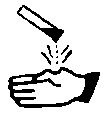Determining if your waste is hazardous
A waste is hazardous if either or both of the
following are true:
- The waste is "listed" on
a regulatory list of hazardous waste (called
a listed waste)
- The waste has the characteristics of
a hazardous waste (called a characteristic waste)*
*Note: A material that is
improperly labeled and potentially hazardous
can also be deemed a hazardous waste. An
example is a bottle of liquid that you don't
recognize and it is a missing label.
Listed Waste
Regulations have compiled lists of waste that are
considered hazardous. To determine if your waste
is hazardous, first determine if the waste meets
one or more of the hazardous waste listing descriptions
found in the regulations. If you generate hazardous
waste, collaborate with the WM group to make
this evaluation.
Characteristic Waste
If the waste is not listed, determine if it exhibits
any of the four characteristics of a hazardous
waste: ignitability, corrosivity, reactivity,
or toxicity. This evaluation involves using
knowledge of the process or materials used to
produce the waste and sometimes involves analytical
testing of the waste.
|
Question |
Example |
Common Symbol |
|
Is the waste toxic? (Can it injure, harm, or make
someone ill if it's inhaled, swallowed, or if it
gets on the skin?) |
- Pesticides
- Waste containing heavy metals (such as
cadmium, chromium, lead, mercury)
|
 |
|
Is the waste reactive? (Will
it or its vapors burn or explode when exposed
to air or water?) |
- Cyanides (such as potassium cyanide,
sodium cyanide)
- Concentrated acids (nitric)
|
 |
|
Is the waste ignitable? (Can
its vapors burn easily?) |
- Fuel: gas/diesel
- Solvents (such as isopropyl alcohol,
or TCA)
- Aerosol products
|
 |
|
Is the waste corrosive? (Will
it burn skin or eyes on contact or "eat
away" containers?) |
- Battery acid
- Acids (such as chromic, nitric, sulfuric,
or hydrochloric)
- Bases (such as sodium hydroxide)
|
 |
General Considerations for Hazardous Waste Determinations
- Fortunately, most of the waste routinely generated
at SLAC has already been evaluated to determine if
it is hazardous. Occasionally a "new" waste
stream is generated and, in those cases, we must determine
if the new waste stream is hazardous.
- The waste evaluation process can be confusing, so
we encourage personnel to work closely with the
WM Group to ensure the waste
is properly evaluated.
- Check the product label, Material
Safety Data Sheet (MSDS), or both. They often
specify the hazards of the material. If it is a hazardous
material, it is likely a hazardous waste.
- Apply your knowledge of the waste and what went
into it. Wastes that are mixtures of materials can
be tricky to evaluate.
- The waste may require analytical testing. WM will
assist in collecting and sending samples to an off-site
laboratory and evaluating the test result.
|